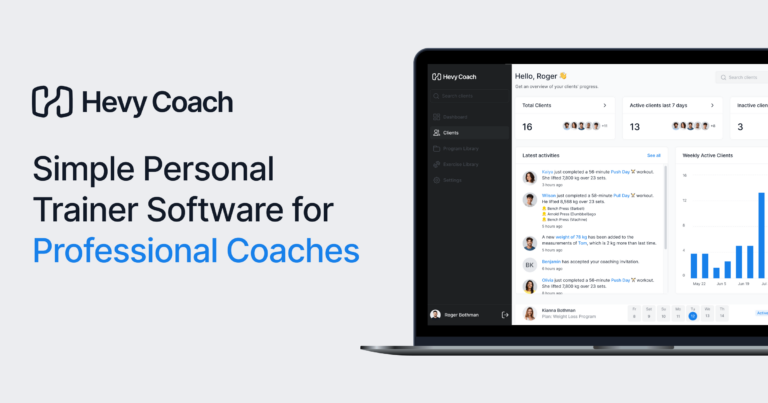With the rapid digitalization of our world, we can do almost everything online. Even personal training has taken up a virtual form, with countless fitness professionals offering online coaching.
While online personal training services might seem like a gimmick that can’t possibly replace in-person coaching, the approach offers unique advantages:
- The ability to work with clients from all over the world
- Teaching clients to be more independent in their training
- Having virtually unlimited room to expand your client roster
- Being able to provide the exact service your clients need
Plus, given how popular online personal training is, you can establish a successful online business, work fewer hours, and earn more.
However, doing so can be challenging, especially if you’re unsure where to start. To that end, we’ve put together this guide to teach you everything there is to know about building a personal training business online.
Determine Your Niche
What It Means and Why Having a Niche is Important
It’s infinitely better to be the right person for a small group of people than to be just another online personal trainer for everyone, which is why you need a niche.
Picking a niche simply means deciding who your ideal client is. Doing so would allow you to focus your marketing efforts and specialize in a particular fitness field to serve your clients better than anyone else.
Think of it like this:
A car mechanic who works on all types of vehicles might do well and have a decent understanding of many car models. However, a mechanic specializing in just one brand (e.g., Subaru) will be far better equipped to diagnose and fix all the problems that type of car can have.
The same goes for specializing as a personal trainer, in-person or online.

Try Hevy Coach
Intuitive personal trainer software, with a world class experience for your clients.
30 day free trial, no credit card required
Examples of Niches for Online Personal Trainers
There are countless niches to pick from. The most popular ones include the following:
- Weight loss
- Bodybuilding (hypertrophy, fat loss, posing, contest preparation, etc.)
- Powerlifting
- Bodyweight training (such as when coaching people who exercise at home)
You can also specialize for people with unique needs:
- Elderly and de-trained individuals
- The previously injured
- Those with health issues or physical limitations (e.g., hip replacement surgery patients)

Here are a couple of examples:
- Jessi McAllister coaches women primarily to get them ready for pregnancy
- Steve Kamb targets nerds, helping them lead healthier lives and get superhero physiques
- Redline Conditioning offers coaching for people wanting to pass physical tests (PARE, POPAT, SOPAT, and COPAT)
Niches will often overlap, at least to some degree, but that doesn’t mean you can’t specialize in a specific field. For example, a hypertrophy coach can work with elderly individuals because they often suffer from sarcopenia and need to build muscle mass (1).
How to Pick Your Niche
As a personal trainer, you’ve hopefully had the opportunity to work with people with unique backgrounds, interests, and fitness goals. These experiences should have given you some idea of who you would like to work with and who might not be a good fit for you.
Picking your niche likely won’t happen overnight. The process takes a while because you must sit down and think about your ideal client. More importantly, you must consider who you can help with your online training services.
Every successful online personal trainer understands that they can’t help everyone. So instead, they specialize by asking themselves questions like:
- Who do I want to work with?
- Who can I help?
- Who would benefit most from my help?
- What type of service can I provide online?
As someone starting with online training, it’s best to focus on a single niche. Of course, you can always broaden your scope later, but start small.
Develop Your Service (and Figure Out the Details)
1. Decide What Service You Will Offer
Once you have a clear idea of your ideal client, decide what kind of service you want to offer and what would make the most sense.
For example, if you decide to work with overweight adults, providing training guidance and a nutrition plan would be best (2). However, offering just one of these would prevent you from delivering the best possible coaching experience that gets people results.
Similarly, if you want to work with newbies who exercise at home, perhaps you should consider 1-on-1 training over video calls. Doing so would take more time, but it would allow you to observe your clients as they train and provide valuable real-time guidance.
Most online personal trainers provide training and nutrition plans to their clients in combination with the following:
- A weekly check-in to track their progress and keep clients accountable
- Communication through chat or email to answer client questions
- Helpful bonus material to teach clients sound fitness fundamentals (typically as PDFs or pre-recorded videos)
As a side note, writing every client’s training program from scratch is time-consuming and inefficient. Instead, use workout templates to speed up and streamline the process.
2. Determine Your Rates
Determining your online personal training rates isn’t as challenging as deciding how much to charge for in-person training. However, there are still a few things to consider, including your reach, reputation, and the services you offer.
A typical online personal trainer charges clients every month and requests a 3-month commitment minimum because that’s the average amount of time it takes to make noticeable progress.
Depending on your service and extras, you can charge anywhere from $100 to $500+ for your monthly services. New online trainers with little reach and no positive reviews should charge less to get started and build their reputation.
In contrast, an established online training business with multiple respected trainers on its payroll and a refined onboarding and coaching system can charge more. Offering extras (consultation calls, additional helpful material, 1-on-1 workout sessions, technique critique, etc.) allows online personal trainers to charge even more.
Charging clients per session is an option that makes it easier for people to commit and try your services before deciding if you’re the right fit. Your rates should be 20 to 40 percent lower than in-person personal training rates because you can’t support your clients as much on video calls.
For example, according to recent data, the average hourly cost for personal training is $55, with high-end services costing as much as $120. You can offer 1-on-1 video calls for 20 percent below the average cost and charge around $45 if you’re new or up to $95 if you’re running an established online fitness business.
Related article: How Much to Charge for a Workout Plan? Here’s How to Decide
3. Take Inspiration From Your Competitors
There is nothing wrong with taking a peek at your competition to see what services they offer, how much they charge, and how they market their online personal training businesses.
Doing so is not just beneficial but mandatory because:
- It gives you good marketing ideas
- You learn how much other coaches charge on average
- You can come up with ways to improve your service and stand out

More importantly, looking at your competition can be a great way to spot opportunities and offer a superior service.
For example, if most coaches only communicate through email, you can offer chatting options to clients. That way, people can reach you more quickly with questions or concerns and have their issues resolved. Hevy Coach is an all-in-one platform that lets you keep track of your entire roster and organize your chats in one place.
4. Figure Out the Details
There are several things you should figure out to be a successful online personal trainer:
- What business structure will you use? It’s best to set up a limited liability company (LLC) or similar to separate yourself from your online business, protect your assets in case of a lawsuit, and be legitimate in case of an IRS audit. Doing so is also beneficial for tracking incomes and expenses to ensure your online business is profitable.
- How will you accept payments? Setting up a Stripe business account is ideal because the platform is easy to use, offers protection, and allows coaches to issue refunds if necessary.
- How will you provide guidance? Communicating with clients through email is a practical solution because you can keep track of everything and send all the necessary files (spreadsheets, PDFs, word files, pre-recorded videos, etc.).
- How will you track client progress? As an experienced coach, you understand how crucial it is to track your clients and ensure they are getting closer to their goals. Using online personal training software such as the Hevy Coach platform is great because you can keep everything in one place: the training plan, progress (body weight, circumference measurements, etc.), chat history, etc.
- How and when will you communicate with clients? Some coaches have a strict rule for communicating with clients once per week to teach independence and reduce the workload. Others offer chat options and encourage clients to ask questions and voice their concerns. You should think about your service and how you would like to deliver your online training service. Clear it up with clients before starting to work together to avoid issues.
- How exactly will you help clients, and what can they expect from you? The final big thing to think about is the essence of your online services. Think about the scope of your service, set clear expectations, and create some boundaries. Discuss these details with your clients early on to be on the same page and avoid confusion.
Running a personal training business will inevitably lead to other questions you must figure out as you go. Of course, it’s impossible to think of everything beforehand, but you should try clarifying as many details as possible, especially those directly related to the coaching process.
Build Your Online Presence
Running a successful business online comes down to two simple but fundamental things:
- Reaching enough people
- Converting a percentage of them into paying clients
Both are simple to understand but quite difficult to pull off, often taking months or years of dedicated effort.
Building an online presence is necessary for reaching enough people and getting your name out there. Without exposure, you would struggle to grow your client roster even with a good marketing message.
Look at it like this:
According to data from MailChimp, a reasonable website conversion rate is between 2 and 5 percent (3). In other words, 2 to 5 percent of visitors will join your email list (more on that in a moment) or make a purchase. So, for every 100 people who visit your website, 2 to 5 will take the action you desire, so long as your marketing message is good.
E-commerce data suggests a good conversion rate to aim for is 2.5 to 3 percent, but that number is likely lower for an online personal training business. The primary reason is that it takes more effort: applying, talking to the prospective coach, deciding if you’re a good fit, etc.
Each hurdle a prospective client needs to jump through makes them more likely to give up and seek a more straightforward solution, such as purchasing an online course.
Put simply, converting people (especially cold leads) to paying clients is difficult. You need exposure to thousands to sign a handful and earn decent money. To that end, here are the three things you should focus on from the start:
1. Build Your Website
Every good online training business needs a website prospective clients can visit to learn more about the services offered, what is required from clients, what they can expect to get, and more.
A website can also be a platform for you (the coach) to share helpful information with visitors and build an audience. You can share information through short blog posts, articles, complete guides, research breakdowns, or whatever else you feel would be helpful.
Regardless of how you decide to approach your website, make sure it has three crucial pages:
- An about page where you include a personal trainer bio and other relevant information
- A contact page where you clearly and specifically outline how visitors can get in touch with you
- A landing page where you describe the service you offer, what clients can expect from working with you, what’s required of them, FAQs, etc.
You should also have some quality photos of yourself, preferably in the gym coaching others, to add to your about and landing pages.
2. Create an Email List
An email list is simply a collection of emails a business can gather to share updates, bonuses, helpful information, and discount offers with people.
It’s best to sign up for a tool like Aweber or MailChimp. These platforms store your subscribers and allow you to send emails to hundreds or thousands of people with just one click.
Growing an email list is valuable because you’re collecting contact information from people interested in what you have to say. For example, if someone finds your article on Google and signs up for your email list through an opt-in form, they are essentially telling you, “I like your stuff. I want to see what else you have.”
Email subscribers are more engaged and far likelier to become paying clients at some point, if not right away.

The best way to grow your email list is to ask people to subscribe in exchange for a free bonus: eBook, content upgrade (bonus material related to a specific article or video topic), email course on a particular subject, discount code, or something else.
Place several opt-in forms on your website (pop-up form, sidebar form, at the bottom of articles, on your landing page, etc.) and state clearly what visitors would get if they subscribed. Once people are on your list, continue to provide value to keep them engaged.
One way to do that is to set up a weekly email newsletter. It could be as simple as writing a quick email where you break down a topic, answer a reader’s question, share tips, and more.
Doing so would allow you to build a relationship with people. Once you have a list of at least 100 subscribers, pitch your online coaching service and encourage those interested to reach out. These emails should still provide value and explain how your service would help the person reach their goals.

Try Hevy Coach
Intuitive personal trainer software, with a world class experience for your clients.
30 day free trial, no credit card required
3. Establish Social Media Profiles
Regardless of how you see social media, platforms like TikTok, Instagram, and even Twitter provide opportunities to market your services, reach more people, and expand your client roster.
Plus, unlike building a website from scratch, doing search engine optimization, and trying to rank on Google, social media offers an element of virality. In other words, you could reach far more people in less time if you share helpful and engaging content.
For example, many people these days find great success on TikTok and YouTube, where they release short and informative or humorous videos. Reaching thousands or even hundreds of thousands of people would make it far easier to sign enough clients to earn good money.
One prominent example of someone who’s achieved great success with that content format is Noel Deyzel. His videos blend motivation, modesty, humor, and helpful information, typically wrapped in 30 to 60 seconds.
Because of his unique style and likable personality, Noel has amassed an impressive following across social media.
Related article: How to Become a Fitness Influencer: 8 Key Areas to Focus On
Market Your Online Personal Training Business
Content & Email Marketing
As discussed previously, sharing helpful information is an effective way to build an email list and get your name out there. Providing valuable content for free makes you the ‘go-to’ person for folks who need fitness guidance.
Most people who enjoy your content will never purchase anything from you, but that doesn’t mean content and email marketing are obsolete.
Even if one percent of your active email subscribers convert into paying clients, you can still build a large roster, so long as the list is large enough and growing every month.
For example, getting your first 100 email subscribers might result in one to two new clients if you market yourself well. However, that number is bound to increase as your email list grows:
- 500 subscribers = 4-5 clients
- 1,000 subscribers = 8-10 clients
- 10,000 subscribers = more coaching requests than you can handle
Getting to that point is easier said than done, but an engaged and steadily growing list will be your best asset.
Social Media
There are a couple of ways to expand your personal training business through social media, both of which are based on regularly sharing helpful and engaging content:
- Direct people to your coaching services (landing page) from your social media posts. For example, if you’re creating short-form helpful videos, dedicate the last ten seconds to pitching your services with a link for people to learn more.
- Direct people to your website or dedicated opt-in page, where they can sign up for your email list.
For most people, a combination of the two tactics would work best because you should leverage social media to grow your list, but it also doesn’t hurt to try and convert some people straight from Instagram, TikTok, or YouTube.
For instance, let’s say you share a short video explaining the benefits of online personal training. In that case, pitching your service would make a lot of sense because you know that people who see the video are at least somewhat interested in getting coached.
However, if the topic you cover isn’t directly related to coaching, perhaps a better tactic would be to try and convert people from social media to your email list. From there, you can introduce yourself, share some bonuses, and provide value consistently, turning cold leads into raving fans.
Then, when you decide to pitch your online training services to your email list, you’re more likely to sign new clients.
Click here to get fitness content ideas.
Paid Advertisement
Paid ads are another venue worth exploring, especially if you’re just starting and don’t have an audience. The right ads can get the ball rolling, providing much-needed exposure and income.
One option is to run some Google ads. These appear on top of the search results, which means they are the first thing people see when they type a keyword related to online personal training.
Facebook ads are another option, though it takes longer to fully understand how they work. The advantage is that you can target specific people based on age, gender, interests, etc. Here is an in-depth guide on Facebook advertising.
YouTube ads are the third good option, especially if you’re good in front of the camera and can create engaging videos. These will show up before the start of videos on YouTube.
Overall, a paid advertisement can work, but expect to make some mistakes. It takes time to hone your message and learn how to create enticing ads that grab people’s attention.
Client Testimonials
Testimonials from happy clients are a powerful form of free advertisement. Even a handful of positive reviews sets you apart from most of your competition.
It all has to do with social proof––a concept in psychology suggesting that other people influence our decision-making.
For example, how do you go about purchasing something online? You probably look at ratings and reviews of customers to determine if the item is worth buying. You’re more likely to get the product with hundreds or thousands of positive reviews.

The same goes when looking to hire a person for their service. We value other people’s opinions and are likelier to work with someone if others vouch for that person.
Unfortunately, getting your first client testimonials is difficult. One option is to reach out to people you’ve coached in person and ask them to write a few lines or record a video, preferably with before and after photographs showcasing their transformation.
Include testimonials on your landing page to boost your credibility and conversion rate.

Try Hevy Coach
Intuitive personal trainer software, with a world class experience for your clients.
30 day free trial, no credit card required
Final Words
Becoming an online personal trainer is a fantastic way to reach more people, earn more money, and spend less time working. However, gaining momentum is often difficult, time-consuming, and frustrating.
It takes time to build an audience, develop a good marketing message, and figure out all the business-related details (your business model, how to accept payments, track clients’ progress, etc.).
The three steps you should take right away are:
- Build a professional-looking website with three core pages: about, contact, and landing pages
- Create an email list and use your website to convert people
- Set up social media profiles and begin sharing helpful and engaging content to build a following
Despite the challenges, online training is a fantastic way to expand your practice because you don’t have to invest much money upfront. You can continue coaching people in person while growing your online influence.
If you’re looking for a coaching platform, check out Hevy Coach. The all-in-one tool keeps all of your clients in one place, makes communication and progress-tracking easy, and allows you to provide the necessary guidance (training program, diet plan, tips, etc.).




